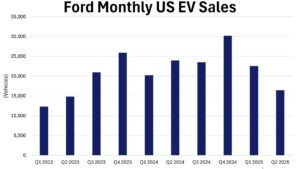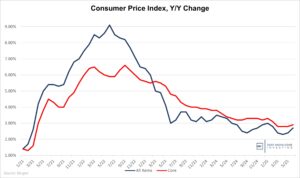Every week in January, we’ve been pointing out the inconsistencies we see in macro-economic data. The trend becomes even more pronounced this week with contradictory insight on the economy being provided by the GDP report, the Fed’s preferred inflation metric, and the purchasing manager’s index. The results are so confusing that commentary by S&P Global seems designed to be misunderstood. Confused? Ok – we are a bit too, but don’t worry: Keep reading for the explanation.
This week, we’ll address the following topics:
- 4Q GDP appears to indicate the economy is in great shape. Do you believe that? We’re skeptical.
- The PCE is showing inflation is falling even faster than expected. Is that what you’re seeing at home? Should the Fed pivot now? We’ll discuss.
- S&P Manufacturing and Services PMI better than expected. This comes with incomprehensible commentary on pricing. Can we provide clarity? We’ll try!
- Las Vegas Sands ($LVS) earnings indicate Singapore gaming is at an all-time high and Macau is almost completely recovered. Should you buy the stock?
- Nuclear power generation is heading for an all-time high. Want carbon-free energy – this is how it happens. How can you make money from this trend? We’re on it.
Ready for a new week of indeterminate and contradictory economic data headlines? Let’s dive in:
1. 4Q GDP Well Above Expectations – Is It Real?:
4Q GDP just got reported at 3.3% which was well-above expectations of 2%. We’re a bit skeptical of that high number for two reasons. First, the price index was up 1.9% for the quarter. We think most Americans are seeing price increases above that and by understating inflation, the government overstates GDP. Second, Congress is still spending like we’re in the middle of a massive recession. The huge Covid spending levels of a few years ago have become a permanent part of government. As a reminder, government spending adds to GDP whether that spending creates any value or not.

It’s a good number. Is it an honest one?
DKI Takeaway: Regardless of whether we think the GDP number is accurate or not, the strong print makes it less likely that the Federal Reserve lowers interest rates at the next meeting. It also gives strength to the arguments being made by those saying we’re heading for a “soft landing”; a reduction of inflation without a recession.
2. Personal Consumption Expenditures Index Below Expectations:
The personal consumption expenditures price index (PCE) is regarded as the Federal Reserve’s preferred measure of inflation. The December PCE was up 2.6% for the year and 0.2% for the month. That was an acceleration from the prior two months where the PCE was between down 0.1% and flat. The Core PCE, which excludes food and energy, was up 2.9% for the year and 0.2% for the month. The monthly increase was the same as the prior month and consistent with expectations. The annual number was slightly below the 3.0% estimate.

The Core number is now declining consistently and is annualizing around the 2% target.
DKI Takeaway: While we’re still skeptical that actual inflation experienced by households is below 3%, there’s no question that inflation is coming down from much higher levels. The fact that prices have remained high and continue to increase indicates that currency printing was the reason for higher prices; not temporary supply chain disruptions as many in government claim. The Core PCE coming down makes a Fed pivot to lower interest rates more likely. I don’t think it happens at the next meeting, but lower inflation puts more pressure on the Fed to cut rates.
3. Purchasing Managers’ Index Better than Expected:
Lately, we’ve seen manufacturing indexes indicating big declines in activity. This week’s S&P Global Flash Purchasing Managers’ Index (PMI) changes that trend and beats expectations. The manufacturing output index of 48.7 is still in contraction, but was above expectations of 47.7. The services index of 52.9 is at a seven-month high and was above expectations of 51.0.

Prices still increasing, but at a slower rate.
DKI Takeaway: Again, we point out the difference between deflation and disinflation. Prices aren’t coming down; but rather, are increasing at a slower rate. Business activity has picked up, but the pricing commentary is mixed. The S&P report says “Inflationary pressures cooled…as input prices rose at a softer pace…Goods producers saw a sharper uptick in cost burdens. The pace of manufacturing input cost inflation picked up to the steepest since April 2023 amid challenges…”. DKI has been commenting on inconsistent data, but this is the most inconsistent commentary I’ve ever seen. Some of this is a split between goods and services, but it’s still an unintentionally funny read.
4. Las Vegas Sands ($LVS) Shows a Massive Recovery in Asia:
The Marina Bay Sands in Singapore had 4Q adjusted property level EBITDA of $544MM. That’s the highest I’ve ever seen in a quarter, and my model goes back to 2016. Sands got lucky at the gaming tables, but even backing out the high hold, it was still a fantastic quarter even by pre-pandemic standards. Backing out the impact of low hold (bad luck) in the quarter, Macau operations have recovered to 90% of the 2018 level with several hotels near 100% occupancy. The mass and premium mass markets are fully recovered which is where $LVS makes most of its money.

DKI Takeaway: In the quarter, $LVS bought back more than $500MM of common stock, paid out over $150MM in dividends, and agreed to buy $250MM of Sands China stock. Sands China is the subsidiary that owns about 30% of the Macau operations. There are legitimate concerns about the health of the Chinese economy, but Las Vegas Sands is starting to perform around pre-pandemic levels and return huge amounts of capital to shareholders. The stock still trades at a distressed level. We think it’s worth a look.
5. Global Nuclear Power Generation Expected to Hit an All-Time High Next Year:
If you want to see reliable baseload electric generation without carbon emissions for a world that becomes more power-hungry every year, nuclear is the only option right now. The International Energy Agency thinks global electricity demand should rise by 3.4% annually over the next few years. They also think nuclear power generation will grow by 3% to an all-time record in 2025.

Nuclear Power Generation by Region. Graph from IEA. HT to @chigirl for the original Tweet.
DKI Takeaway: Current demand for uranium exceeds current annual mining capacity. New nuclear plants and agreements to keep older plants operational for longer mean demand is going to go up before suppliers have time to complete multi-year capacity expansion projects. Uranium prices are up a lot and with an increasing supply/demand imbalance could continue to rise. Want a suggestion for the best way to get exposure to this investment idea? Reach out and we can help.
Information contained in this report, and in each of its reports, is believed by Deep Knowledge Investing (“DKI”) to be accurate and/or derived from sources which it believes to be reliable; however, such information is presented without warranty of any kind, whether express or implied. DKI makes no representation as to the completeness, timeliness, accuracy or soundness of the information and opinions contained therein or regarding any results that may be obtained from their use. The information and opinions contained in this report and in each of our reports and all other DKI Services shall not obligate DKI to provide updated or similar information in the future, except to the extent it is required by law to do so.
The information we provide in this and in each of our reports, is publicly available. This report and each of our reports are neither an offer nor a solicitation to buy or sell securities. All expressions of opinion in this and in each of our reports are precisely that. Our opinions are subject to change, which DKI may not convey. DKI, affiliates of DKI or its principal or others associated with DKI may have, taken or sold, or may in the future take or sell positions in securities of companies about which we write, without disclosing any such transactions.
None of the information we provide or the opinions we express, including those in this report, or in any of our reports, are advice of any kind, including, without limitation, advice that investment in a company’s securities is prudent or suitable for any investor. In making any investment decision, each investor should consult with and rely on his or its own investigation, due diligence and the recommendations of investment professionals whom the investor has engaged for that purpose.
In no event shall DKI be liable, based on this or any of its reports, or on any information or opinions DKI expresses or provides for any losses or damages of any kind or nature including, without limitation, costs, liabilities, trading losses, expenses (including, without limitation, attorneys’ fees), direct, indirect, punitive, incidental, special or consequential damages.




